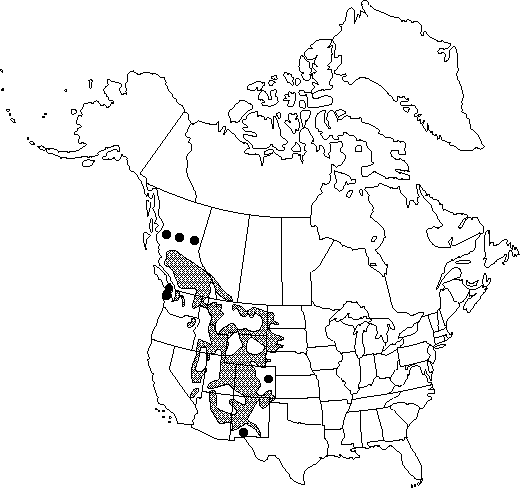Juniperus scopulorum
Gard. & Forest 10: 420, fig. 54. 1897.
Trees dioecious, to 20 m, single-stemmed (rarely multistemmed); crown conic to occasionally rounded. Bark brown, exfoliating in thin strips, that of small branchlets (5–10 mm diam.) smooth, that of larger branchlets exfoliating in plates. Branches spreading to ascending; branchlets erect to flaccid, 3–4-sided in cross-section, ca. 2/3 or less as wide as length of scalelike leaves. Leaves light to dark green but often glaucous blue or blue-gray, abaxial gland elliptic, conspicuous, exudate absent, margins entire (at 20× and 40×); whip leaves 3–6 mm, not glaucous adaxially; scalelike leaves 1–3 mm, not overlapping to overlapping by not more than 1/5 their length, keeled to rounded, apex obtuse to acute, appressed or spreading. Seed-cones maturing in 2 years, of 2 distinct sizes, generally with straight peduncles, globose to 2-lobed, 6–9 mm, appearing light blue when heavily glaucous, but dark blue-black beneath glaucous coating when mature (or tan beneath glaucous coating when immature), resinous to fibrous, with (1–) 2 (–3) seeds. Seeds 4–5 mm. 2n = 22.
Habitat: Rocky soils, slopes, and eroded hillsides
Elevation: 1200–2700 m (0 m at Vancouver Island and Puget Sound)
Distribution

Alta., B.C., Ariz., Colo., Idaho, Mont., Nebr., Nev., N.Mex., N.Dak., Oreg., S.Dak., Utah, Wash., Wyo., n Mexico
Discussion
Juniperus scopulorum hybridizes with its eastern relative J. virginiana in zones of contact in the Missouri River basin (C. W. Comer et al. 1982) and with J. horizontalis (J. × fassettii Boivin; N. C. Fassett 1945). Relictual hybridization with J. virginiana is known in the Texas panhandle (R. P. Adams 1983).
Selected References
None.
Lower Taxa
"not/" is not declared as a valid unit of measurement for this property. "not" is not declared as a valid unit of measurement for this property."thick" is not a number.